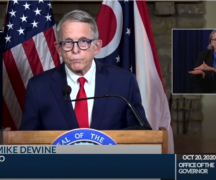Ohio joins list of states with highest rates
BY LAURA OLSON
WASHINGTON — The number of states with high obesity among residents has nearly doubled since 2018, according to new data Wednesday from the U.S. Centers for Disease Control and Prevention.
There were 16 states that had obesity rates among adult residents of at least 35% last year, with Ohio, Iowa, Delaware and Texas on that list for the first time. That’s an increase from 12 states in 2019 and nine states in 2018.
Ohio had an obesity rate of 35.5%, with 10.5% self-reported from Asian adults, 34.2% among non-Hispanic white adults, 39.7% among Hispanic adults, and 40.5% among non-Hispanic Black adults.
Officials with the Association of State and Territorial Health Officials described the obesity rates as having hit all-time highs, and that they signal how the COVID-19 pandemic exacerbated the decades-long pattern of obesity in the U.S.
“Our attention on COVID-19 diverted us from focusing on chronic disease prevention, which we need to get back to,” said Marcus Plescia, chief medical officer at the association. “We must get back on track to assure that we have the policies, systems and environments in place to support equitable access to physical activity opportunities and nutrition security for all.”
As recently as 2012, no state had an adult obesity rate above 35 percent, according to the Trust for America’s Health, a D.C.-based health policy organization.
Last year, more than 20% of adults in every state were obese, according to the CDC.
Mississippi had the highest rate nationally, at 39.7%.
Others that ranked high were Alabama, Arkansas, Indiana, Kansas, Kentucky, Louisiana, Michigan, Oklahoma, South Carolina, Tennessee, and West Virginia.
Colorado had the lowest obesity rate, at 24.2 percent.
Others in the lowest tier — between 20% and 25% — were Hawaii, Massachusetts, and the District of Columbia.
The obesity rates are based on self-reported height and weight data gathered through telephone surveys on health-related risk behaviors, chronic health conditions, and use of preventive services.
Analyzing obesity rates from 2018 to 2020, federal health researchers identified racial, educational and regional trends.
No state had an obesity prevalence at or above 35% among Asian residents, seven had high obesity rates among white residents, 22 had high rates among Hispanic residents, and 35 states had obesity rates at or above 35% among Black residents.
Among adults without a high school degree, obesity rates were 38.8%, while it was 25% among college graduates.
The Midwest and South had the highest levels of obesity among residents, at 34.1% in each region.
Western states had a rate of 29%, with 28% among residents in the Northeast.
***
Also from Ohio Capital Journal:
Huffman defends his maps, redistricting process despite no bipartisan support
State Senate President Matt Huffman defended decisions he and Republican members of the Ohio Redistricting Commission made as they moved forward with a partisan, four-year redistricting plan for the state.
Just after midnight on Thursday, maps filed under his name passed through the commission on a 5-2 party-line vote. The maps were only slightly different than maps he and the Republican caucus had presented and which was formally introduced as the commission map little more than a week ago.
The maps were approved after a full day of talks between commission members and staffers that ended less than an hour before the midnight deadline.
“What it really came down to is at some point a decision had to be made and somebody has to do the work to get to the decision,” Huffman said in a press conference on Thursday.
Huffman defended the maps and the constitutionality of the maps, despite strong criticism from anti-gerrymandering advocates, political science professors and public citizens across the state. READ MORE
GOP Ohio senator fought to repeal corrupt law; party leaders drew him out of his district
New lines drawn by state GOP leaders ousted Sen. Mark Romanchuk, a Republican from Richland County, from the district that elected him to his seat in 2020.
Since the indictment of the former speaker of the House last summer and subsequent guilty pleas from four alleged co-conspirators, Romanchuk has led the charge among Ohio Republicans to repeal House Bill 6, the legislation at the center of the racketeering prosecution.
He has sponsored four substantive bills this legislative session, three of which are aimed to repeal different elements of HB 6 including forcing utility customers to guarantee revenue at 2018 levels for utility company FirstEnergy Corp. (which pleaded guilty to a lesser charge after admitting to its role in a bribery scheme), and another repealing utility customer-funded bailouts to the utility companies that own two coal plants in Ohio and Indiana.
A Romanchuk aide confirmed Thursday that the senator now lives in a new Senate district and said he didn’t know why Romanchuk was removed from his former district. READ MORE





